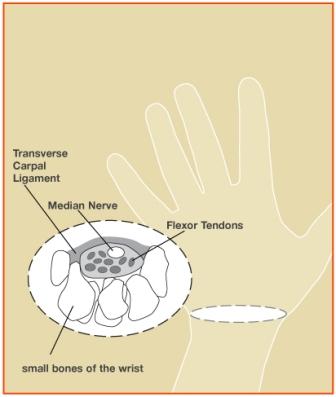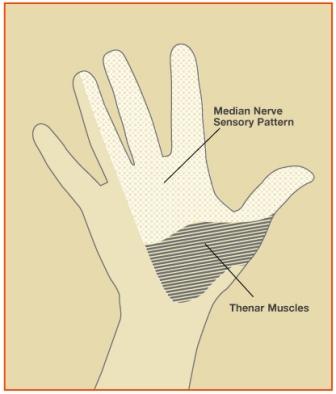Carpal tunnel syndrome is the most common nerve problem in the hand. It results from increased pressure on the median nerve at the wrist, within the carpal tunnel. Symptoms such as numbness, tingling, weakness, and hand pain can result if the nerve is compressed or “pinched.”
The word “carpus” means “wrist.” The carpal tunnel is a passageway in the wrist through which the median nerve and tendons of the hand travel. The carpal tunnel is a narrow space: the floor of the tunnel is made up by the carpal bones of the wrist, and the roof is created by the transverse carpal ligament. The median nerve is at risk for being pinched within this tunnel. If there is abnormal swelling, altered wrist anatomy, or injury to this area, the function of the median nerve may be affected.
WHAT CAUSES CARPAL TUNNEL SYNDROME (CTS)?
In most cases, the cause of CTS is unknown. Thyroid disorders, rheumatoid arthritis, pregnancy, vitamin deficiencies, diabetes, fluid retention, and trauma can be associated with CTS. Women are more commonly affected than men. Repetitive, forceful gripping and heavy use of vibratory tools may increase the risk of CTS.
HOW DO I KNOW IF I HAVE CARPAL TUNNEL SYNDROME?
Patients with CTS commonly feel numbness and tingling in the fingers. Some patients feel that the fingertips are asleep or report poor circulation in the hands. Symptoms are often worse at night and people tend to shake their hands for relief. Some patients report increased symptoms while gripping a steering wheel. Dropping objects, clumsiness with the hands, or a weak grip are also common complaints. Some people also report pain in the forearm, wrist or fingers. In severe cases, the muscles at the base of the thumb (thenar muscles) can become weak and atrophy. See image below.
Often the diagnosis can be made based on your symptoms and physical examination. A nerve study can be ordered to confirm the diagnosis in some cases.
WHAT ARE THE TREATMENT OPTIONS?
Not everyone with carpal tunnel syndrome needs surgery. Many people with CTS improve with non-operative treatment. Wearing a wrist brace at night supports the wrist in good alignment and takes pressure off the nerve. Corticosteroid injections provide an anti-inflammatory effect and can be effective in many patients.
If nerve compression is severe, or if conservative treatment does not help, carpal tunnel surgery may be recommended. A carpal tunnel release (CTR) is performed to decrease pressure on the median nerve. During this procedure, the “roof” of the carpal tunnel (the transverse carpal ligament) is divided. Cutting the transverse carpal ligament increases the size of the carpal tunnel and provides more room for the median nerve.
The type of surgical incision varies among surgeons; however, the common goal is to reduce pressure on the median nerve. Open CTR and endoscopic CTR are two surgical options. The recommended procedure will be discussed with you with your doctor. Raleigh Hand Center physicians are experts in carpal tunnel syndrome treatment.




